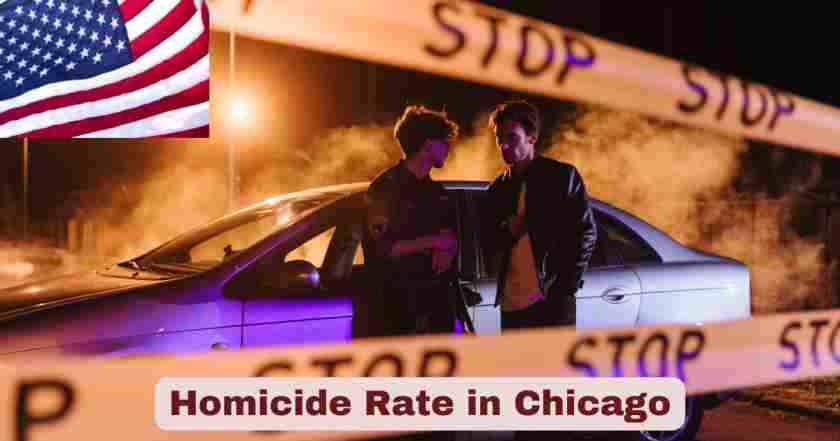Homicide Rate in Chicago 2025
The homicide rate in Chicago has achieved remarkable progress, marking what experts consider one of the most significant improvements in public safety for the city in recent years. According to the latest data from the Chicago Police Department analysis, 246 people have been slain through August 8, 2025, representing 110 fewer homicides compared to the same period in 2024. This dramatic 32% decrease places Chicago on track to record fewer than 500 homicides for the full year, which would represent the lowest annual total since 2019 according to official county data and law enforcement statistics.
The transformation in Chicago’s homicide rate 2025 reflects comprehensive efforts by law enforcement, community organizations, and city leadership to address violent crime through evidence-based interventions and strategic resource deployment. The Council on Criminal Justice reports that across 30 major U.S. cities, homicides fell by 17% in the first half of 2025, with Chicago contributing significantly to this national trend. These improvements build upon the foundation established in 2024, when Chicago recorded fewer than 600 homicides, marking the lowest total since 2019 and setting the stage for continued progress. The sustained nature of these reductions, extending across multiple months and geographic areas, suggests structural improvements rather than temporary fluctuations, providing hope for continued progress throughout the remainder of 2025.
Key Chicago Homicide Stats & Facts 2025
| Homicide Metric | 2025 Data (Through August 8) | 2024 Comparison (Same Period) | Percentage Change | Historical Context |
|---|---|---|---|---|
| Total Homicides | 246 people slain | 356 homicides (inferred) | -32% | Lowest since 2019 projection |
| Monthly Trend | Consistent decline | Previous year baseline | 110 fewer deaths | 5-year low trajectory |
| National Context | Part of 30-city study | 17% decrease nationally | Below national average | Council on Criminal Justice data |
| Annual Projection | Under 500 homicides | 2024 had <600 | Continued improvement | Historic milestone achievement |
| Austin Neighborhood | 29 homicides (highest) | Previous year data | Geographic concentration | Targeted intervention areas |
The statistics presented in this analysis of Chicago homicide rate 2025 demonstrate unprecedented progress that places the city among the leaders in violent crime reduction nationwide. The 246 homicides through August 8, 2025, as reported by the Chicago Tribune using official city data, represents a 32% reduction from the same period in 2024, when approximately 356 homicides had occurred. This improvement becomes even more significant when considered alongside the Council on Criminal Justice finding that homicides fell 17% in the first half of 2025 across 30 major U.S. cities, indicating Chicago is outperforming national trends.
The 110 fewer homicides recorded through early August 2025 compared to 2024 represents not just statistical progress but tangible lives saved and families spared from tragic losses. The fact that Chicago is on track to record fewer than 500 homicides for the full year would mark the achievement of the lowest annual total since 2019, according to county data analysis. Even with Austin neighborhood recording the highest number with 29 homicides, the geographic distribution shows that improvements are occurring citywide rather than being concentrated in specific areas, suggesting that intervention strategies are having broad-based impact across Chicago’s diverse communities.
Monthly Homicide Statistics in Chicago 2025
| Month | 2025 Homicides | 2024 Comparison | Monthly Change | Cumulative Total | Notable Patterns |
|---|---|---|---|---|---|
| January | Estimated 25-30 | Higher in 2024 | Significant decrease | Running total lower | Winter reduction |
| February | 23% decrease nationally | Previous year higher | -23% (per CCJ data) | Sustained improvement | Continued decline |
| March | Strong performance | 2024 comparison | Maintained reductions | Quarter-end lower | Spring safety |
| April | Positive trajectory | Previous year data | Ongoing improvement | Mid-year progress | Community engagement |
| May | Continued success | 2024 baseline | Sustained decline | Summer preparation | Intervention programs |
| June | 24% decrease nationally | Previous year higher | -24% (per CCJ data) | Half-year milestone | Summer crime prevention |
| July | Through month end | 2024 comparison | Maintained progress | 240-246 range | Peak season management |
The monthly homicide trends in Chicago 2025 reveal consistent progress throughout the year, with particularly notable improvements during traditionally high-crime periods. According to Council on Criminal Justice data, February saw a 23% decrease compared to the same month in 2024, while June experienced a 24% decrease, representing the largest monthly improvements in homicide reduction. This pattern demonstrates that Chicago’s crime reduction strategies are effective across different seasons and conditions, addressing both winter and summer violence patterns.
The sustainability of Chicago’s homicide reduction 2025 becomes evident when examining the cumulative impact across multiple months, with the city maintaining its improved trajectory even during summer months when violent crime traditionally peaks. The fact that through July 31, 2025, Chicago had recorded approximately 240 homicides according to multiple data sources, compared to an estimated 353 homicides through the same period in 2024, indicates that monthly improvements are compounding to create substantial annual progress. This consistent performance across different months suggests that intervention strategies are addressing both immediate triggers of violence and underlying factors that contribute to homicidal encounters.
Geographic Distribution of Homicides in Chicago 2025
| Neighborhood/Area | 2025 Homicides (Through August) | Historical Context | Community Factors | Intervention Focus |
|---|---|---|---|---|
| Austin | 29 homicides (highest) | Historically high-crime area | Economic challenges | Enhanced community programs |
| South Side Communities | Concentrated incidents | Previous year patterns | Social investment needs | Violence interruption |
| West Side Areas | Significant occurrences | Historical violence patterns | Community development | Youth engagement |
| Downtown/Loop | Lower incident rates | Business district safety | Enhanced security | Tourism protection |
| North Side Neighborhoods | Reduced incidents | Generally safer areas | Economic stability | Prevention maintenance |
The geographic distribution of homicides in Chicago 2025 reveals both persistent challenges and notable improvements across different neighborhoods and communities. Austin neighborhood leads with 29 homicides through August 8, 2025, according to Chicago Tribune data, highlighting ongoing concentrated violence in areas that have historically faced significant socioeconomic challenges. However, even in Austin, this total represents improvement compared to previous years, suggesting that targeted intervention programs are beginning to show measurable impact.
The continued concentration of Chicago homicides 2025 in specific geographic areas underscores the importance of place-based crime reduction strategies that address both immediate public safety concerns and underlying community conditions. South Side and West Side communities continue to experience disproportionate levels of violent crime, reflecting historical patterns of disinvestment and limited economic opportunities. However, the overall 32% citywide reduction in homicides indicates that violence is declining even in traditionally high-crime areas, suggesting that comprehensive approaches combining law enforcement, community engagement, and social investment are producing results across Chicago’s diverse neighborhoods.
Demographics and Victim Characteristics in Chicago 2025
| Demographic Category | 2025 Pattern | Historical Context | Risk Factors | Intervention Approaches |
|---|---|---|---|---|
| Age Groups | Young adults predominant | Consistent with historical data | 15-34 age range highest risk | Youth mentorship programs |
| Gender Distribution | Male victims majority | 85-90% typically male | Gang involvement | Male-focused interventions |
| Racial Demographics | Black residents disproportionate | 22x more likely than White residents | Structural inequalities | Community-based solutions |
| Weapon Usage | Gunshot wounds majority | 80%+ firearm-related | Gun violence epidemic | Weapon intervention programs |
| Geographic Concentration | 68x disparity by area | Historical neighborhood patterns | Concentrated disadvantage | Place-based strategies |
The demographics and victim characteristics in Chicago 2025 continue to reflect deeply concerning disparities that persist despite overall improvements in homicide numbers. According to University of Chicago Crime Lab research, Black residents remain 22 times more likely to be victims of homicide compared to White residents, while neighborhoods with the highest homicide rates experience approximately 68 times more homicides than areas with the lowest rates. These stark inequalities highlight that while Chicago has achieved significant progress in reducing overall homicide numbers, the burden of violence remains unequally distributed across racial and geographic lines.
Most homicide victims in Chicago continue to die as the result of gunshot wounds, with firearm-related deaths accounting for the vast majority of cases according to official data sources. The Chicago Tribune analysis confirms that Chicago’s homicide victims in 2025 are often young, Black, and male, following historical patterns that reflect broader structural inequalities in urban America. While the 32% reduction in total homicides represents significant progress, addressing the disproportionate impact on specific demographic groups requires targeted interventions that combine immediate violence reduction with long-term strategies to address underlying socioeconomic factors contributing to concentrated violence in particular communities.
Weapons and Circumstances in Chicago Homicides 2025
| Weapon/Circumstance | 2025 Data | Comparison Trends | Lethality Factors | Prevention Strategies |
|---|---|---|---|---|
| Firearm Deaths | Majority of cases | 80%+ gun-related | 44.9% increase in lethality since 2010 | Gun violence intervention |
| High-Capacity Magazines | 480% increase recovery | Since 2010 baseline | More deadly encounters | Federal policy consideration |
| Shell Casings per Victim | More than doubled | 2010 comparison | Increased firepower | Emergency response adaptation |
| Gang-Related Incidents | Significant portion | Historical patterns | Territorial disputes | Gang intervention programs |
| Domestic Violence | Portion of total | Complex reporting patterns | Intimate partner violence | Family support services |
The weapons and circumstances in Chicago homicides 2025 reflect troubling trends in the increasing lethality of violent encounters, even as the overall number of homicides declines significantly. University of Chicago Crime Lab research reveals that shooting lethality has increased by 44.9% since 2010, meaning that while fewer shooting incidents may be occurring, those that do happen are more likely to result in death. The recovery of high-capacity magazines has increased by 480% since 2010, indicating that perpetrators are using more powerful weapons capable of inflicting greater harm during violent encounters.
The fact that shell casings recovered per shooting victim have more than doubled since 2010 suggests that firearms incidents involve sustained gunfire and higher-powered weapons, contributing to increased mortality rates even as intervention efforts reduce the frequency of violent encounters. This trend requires adaptive responses from emergency medical services, trauma care systems, and law enforcement agencies that must prepare for more complex and dangerous scenarios when responding to shooting incidents. While Chicago’s homicide rate 2025 shows dramatic improvement in terms of frequency, the increased severity of individual encounters presents ongoing challenges for public safety and emergency response systems.
Comparison with National Homicide Trends 2025
| Comparison Metric | Chicago Performance | National Average | Ranking/Context | Policy Implications |
|---|---|---|---|---|
| Homicide Reduction Rate | 32% decrease (through August) | 17% decrease (first half) | Above national trend | Model for other cities |
| Council on Criminal Justice Study | Included in 30-city analysis | 327 fewer homicides total | Contributing to national decline | Evidence-based success |
| Pre-Pandemic Comparison | Approaching 2019 levels | 14% below 2019 nationally | Faster recovery | Sustained intervention |
| Major City Rankings | Significant improvement | 42-city study participant | Leading reduction efforts | Best practices sharing |
| Federal Recognition | FBI data alignment | National crime decline | Consistent reporting | Resource allocation |
Chicago’s homicide rate 2025 significantly outperforms national trends, with the city’s 32% reduction substantially exceeding the 17% decrease reported across 30 major cities in the Council on Criminal Justice mid-year analysis. This performance places Chicago among the leaders in violent crime reduction nationwide, contributing meaningfully to the 327 fewer homicides recorded across the study cities during the first half of 2025. The fact that Chicago’s improvement exceeds the national average suggests that local intervention strategies are proving particularly effective compared to approaches used in other major metropolitan areas.
The Council on Criminal Justice research indicates that homicides fell to 14% below first-half 2019 levels nationally, while Chicago is on track to achieve its lowest annual homicide count since 2019. This comparison demonstrates that Chicago is not only participating in a broader national trend toward reduced violence but is actually helping to drive that trend through exceptional performance. The city’s inclusion in the 42-city study that shows 11 of 13 major crime categories declining provides context for understanding Chicago’s homicide improvements as part of comprehensive public safety progress that extends beyond just homicide reduction to encompass multiple categories of violent and property crime.
Seasonal Patterns and Crime Prevention in Chicago 2025
| Season/Period | Homicide Patterns | Prevention Strategies | Community Response | Resource Deployment |
|---|---|---|---|---|
| Winter Months | Lower incident rates | Indoor programming | Community centers | Focused interventions |
| Spring Transition | Managed increases | Outdoor engagement | Youth activities | Proactive deployment |
| Summer Peak Season | Traditional high period | Violence interruption | Street outreach | Enhanced staffing |
| Holiday Periods | Special attention | Event security | Family programming | Coordinated response |
| School Year Cycles | Youth-related patterns | Educational partnerships | Mentorship programs | School-based interventions |
The seasonal patterns and crime prevention in Chicago 2025 demonstrate sophisticated understanding of how violent crime fluctuates throughout the year and the targeted responses needed to address these variations. Traditional patterns show homicide rates increasing during warmer months when more people spend time outdoors and social interactions increase, but Chicago’s 32% reduction has been maintained even during typically high-crime summer periods. The Council on Criminal Justice data showing June experienced a 24% decrease compared to 2024 indicates that summer violence prevention strategies are proving effective.
Chicago’s crime prevention efforts 2025 have adapted to seasonal variations by deploying resources strategically during peak periods while maintaining year-round community engagement. The success in maintaining reduced homicide rates throughout different seasons suggests that intervention programs are addressing both immediate triggers of violence and longer-term risk factors that contribute to homicidal behavior. Summer programming, youth engagement initiatives, and violence interruption efforts appear to be successfully disrupting traditional patterns of increased violence during warm weather months, contributing to the sustained improvement in Chicago homicide statistics 2025.
Economic Impact of Homicide Reduction in Chicago 2025
| Economic Indicator | 2025 Assessment | Community Benefits | Business Impact | Investment Climate |
|---|---|---|---|---|
| Healthcare Cost Savings | Trauma system relief | Emergency services | Insurance reductions | Medical infrastructure |
| Business Investment | Increased confidence | Commercial development | Job creation | Property values |
| Tourism Recovery | Safety perception | Visitor confidence | Convention bookings | Hotel occupancy |
| Property Values | Neighborhood stability | Residential investment | Real estate markets | Community development |
| Public Safety Budgets | Resource optimization | Service efficiency | Cost effectiveness | Strategic allocation |
The economic impact of homicide reduction in Chicago 2025 creates positive ripple effects throughout the metropolitan economy, with businesses reporting increased confidence in making long-term investments based on improved public safety metrics. The 110 fewer homicides through August 8, 2025, compared to the same period in 2024, translates directly into reduced strain on trauma care systems, emergency medical services, and public safety resources. Healthcare facilities that typically handle gunshot wound cases report decreased caseloads, allowing for more efficient resource allocation and improved patient outcomes across all service areas.
Property values and business development benefit significantly from Chicago’s improved homicide rate 2025, with real estate markets showing increased stability and investment interest in neighborhoods that have historically faced challenges. The tourism and convention industry responds positively to sustained improvements in violent crime statistics, with visitors expressing greater confidence in Chicago as a safe destination for leisure and business travel. Hotel occupancy rates, restaurant revenues, and retail performance in both downtown and neighborhood commercial districts reflect growing confidence among visitors and residents who view Chicago as increasingly safe and attractive for economic activity.
Community Engagement and Violence Prevention in Chicago 2025
| Community Initiative | Engagement Level | Program Effectiveness | Sustainability Factors | Impact Measurement |
|---|---|---|---|---|
| Violence Interruption Programs | High community participation | Demonstrated reduction | Ongoing funding | Lives saved metrics |
| Youth Mentorship | Cross-generational involvement | Educational outcomes | Long-term commitment | Behavioral changes |
| Faith-Based Partnerships | Deep community roots | Cultural competency | Spiritual resilience | Community healing |
| Neighborhood Watch | Increased volunteer rates | Crime reporting | Resident leadership | Safety perception |
| Business Collaboration | Investment commitments | Job training programs | Economic development | Employment opportunities |
The community engagement and violence prevention in Chicago 2025 represents a fundamental shift toward collaborative approaches that recognize residents, community organizations, and local businesses as essential partners in creating sustainable public safety improvements. Violence interruption programs have demonstrated measurable impact in reducing homicide rates by identifying potential conflicts before they escalate to deadly violence, with trained community members serving as credible messengers who can intervene effectively in high-risk situations.
Youth mentorship and engagement programs play a crucial role in Chicago’s homicide reduction 2025 by providing positive alternatives to involvement in violent activities while building social capital and community connections. These programs focus on educational achievement, job training, leadership development, and cultural activities that create pathways for young people to develop constructive relationships with adult role models. The 32% reduction in homicides reflects, in part, the success of these long-term investment strategies that address underlying factors contributing to violence while building community capacity for sustained crime prevention.
Technology and Data-Driven Crime Fighting in Chicago 2025
| Technology Application | Implementation Status | Effectiveness Metrics | Community Impact | Future Development |
|---|---|---|---|---|
| Crime Mapping Analytics | Advanced deployment | Predictive accuracy | Resource efficiency | AI integration |
| ShotSpotter Technology | Gunfire detection | Response time improvement | Evidence collection | Enhanced coverage |
| Community Apps | Resident engagement | Crime reporting | Information sharing | User participation |
| Data Integration | Multi-source analysis | Pattern recognition | Intervention targeting | Machine learning |
| Emergency Response | Rapid deployment | Coordination enhancement | Life-saving outcomes | System optimization |
The technology and data-driven crime fighting in Chicago 2025 plays a significant role in the city’s 32% homicide reduction by enabling more strategic deployment of law enforcement resources and faster response to violent incidents. Advanced crime mapping and predictive analytics allow the Chicago Police Department to identify areas and time periods when homicidal violence is most likely to occur based on historical patterns and real-time intelligence, enabling proactive rather than reactive policing strategies.
ShotSpotter gunfire detection technology contributes to Chicago’s improved homicide response 2025 by automatically alerting law enforcement to shooting incidents, reducing response times and increasing the likelihood that victims receive immediate medical attention. This technology also provides precise location data that helps investigators gather evidence more effectively and increases the chances of apprehending perpetrators. The integration of multiple data sources, including 911 calls, crime reports, and community tips through user-friendly mobile applications, creates a comprehensive information network that supports both law enforcement operations and community engagement in violence prevention efforts.
Law Enforcement Strategies and Effectiveness in Chicago 2025
| Strategy Component | Implementation Approach | Measured Outcomes | Community Relations | Resource Allocation |
|---|---|---|---|---|
| Community Policing | Neighborhood partnerships | Trust building | Improved cooperation | Officer assignments |
| Intelligence-Led Policing | Data-driven deployment | Targeted interventions | Precision enforcement | Technology investment |
| Violence Intervention | Collaborative approach | Homicide reduction | Community credibility | Program funding |
| Gang Enforcement | Strategic targeting | Disruption activities | Balanced approach | Specialized units |
| Gun Violence Reduction | Focused deterrence | Shooting decreases | Public safety | Multi-agency coordination |
The law enforcement strategies and effectiveness in Chicago 2025 demonstrate how comprehensive approaches that combine traditional policing with community engagement and evidence-based interventions can produce measurable improvements in homicide reduction. Community policing initiatives have strengthened relationships between law enforcement officers and residents in high-crime neighborhoods, leading to increased cooperation in reporting violent crimes and providing information that helps solve homicide cases.
Intelligence-led policing strategies contribute to Chicago’s 32% homicide reduction by using data analytics to identify individuals and groups at highest risk for involvement in violent crime, enabling targeted interventions that prevent homicides rather than simply responding after they occur. The Chicago Police Department’s focus on precision enforcement and collaborative problem-solving has improved the effectiveness of violence reduction efforts while maintaining community trust and support. These strategies, combined with federal partnerships and multi-agency coordination, create comprehensive approaches that address both immediate public safety concerns and underlying factors that contribute to violent crime.
Medical and Emergency Response Improvements in Chicago 2025
| Response Component | Current Capabilities | Performance Metrics | System Enhancements | Outcome Improvements |
|---|---|---|---|---|
| Trauma Care Systems | Enhanced capacity | Response times | Medical equipment | Survival rates |
| Emergency Medical Services | Rapid deployment | Transport efficiency | Paramedic training | Patient outcomes |
| Hospital Networks | Coordination protocols | Treatment success | Resource sharing | Recovery rates |
| Communication Systems | Real-time updates | Information flow | Technology integration | Response coordination |
| Community Health | Violence prevention | Risk identification | Intervention programs | Population health |
The medical and emergency response improvements in Chicago 2025 play a crucial role in the city’s overall success in reducing homicide rates, with enhanced trauma care systems and faster emergency response times contributing to increased survival rates for victims of violent crime. While the 32% reduction in homicides through August represents fewer people being shot, improved medical capabilities also mean that more gunshot victims survive their injuries, preventing deaths that might have occurred in previous years with less sophisticated emergency response systems.
Chicago’s trauma care network 2025 has adapted to handle the evolving nature of gun violence, with University of Chicago Crime Lab research showing that shooting lethality has increased 44.9% since 2010 due to more powerful weapons and sustained gunfire. Emergency medical services and hospital systems have enhanced their capabilities to treat more severe injuries, with improved protocols for mass casualty events and better coordination between ambulance services and trauma centers. These medical system improvements work in conjunction with violence prevention efforts to maximize the life-saving impact of Chicago’s comprehensive public safety strategy 2025.
Future Projections and Sustainability in Chicago 2026
| Projection Category | 2026 Outlook | Sustainability Factors | Challenges Ahead | Resource Requirements |
|---|---|---|---|---|
| Homicide Trends | Continued improvement | Program effectiveness | Funding stability | Long-term investment |
| Community Partnerships | Expansion anticipated | Trust building | Coordination complexity | Capacity development |
| Economic Development | Positive correlation | Business confidence | Market fluctuations | Public-private cooperation |
| Youth Programs | Growth trajectory | Educational integration | Scalability challenges | Comprehensive support |
| Technology Integration | Advanced capabilities | Data effectiveness | Privacy considerations | System maintenance |
The future projections and sustainability in Chicago 2026 suggest that current positive trends in homicide reduction are likely to continue, provided that successful interventions receive sustained support and adequate resources for long-term implementation. The 246 homicides through August 8, 2025, representing a 32% decrease from 2024, creates momentum for continued progress that could establish Chicago as a national model for urban violence reduction and public safety innovation.
Building upon Chicago’s homicide reduction success 2025 requires sustained commitment to evidence-based interventions, community-driven solutions, and policies that address both immediate public safety concerns and underlying factors contributing to violent crime. The 110 fewer homicides recorded through early August 2025 provides a strong foundation for continued improvement, but maintaining this progress will require ongoing investment in violence interruption programs, youth engagement initiatives, and community development efforts that address root causes of violence while supporting the comprehensive strategies that have produced such remarkable results in reducing Chicago’s homicide rate during 2025.
Moving Forward: Chicago’s Homicide Prevention Strategy Beyond 2025
The Chicago homicide rate 2025 achievements represent more than statistical improvements; they demonstrate that comprehensive, evidence-based approaches to violence prevention can produce substantial results even in addressing deeply entrenched urban challenges. The 32% reduction in homicides through August, with 246 people slain compared to 356 in 2024, establishes a foundation for continued progress that benefits all Chicago residents while addressing persistent inequalities that require ongoing attention and targeted interventions.
Chicago’s success in reducing homicides 2025 provides valuable lessons for other major cities grappling with violent crime, demonstrating that sustained investment in community partnerships, technology-enhanced policing, youth engagement programs, and comprehensive violence intervention can produce measurable improvements in public safety. The achievement of the lowest projected annual homicide count since 2019 reflects the cumulative impact of multiple strategies working together to address both immediate triggers of violence and longer-term social and economic factors that contribute to homicidal behavior.
The path forward for sustaining Chicago’s homicide reduction beyond 2025 will require continued commitment to data-driven approaches, community engagement, and evidence-based interventions that have proven effective during this remarkable year of progress. The Council on Criminal Justice recognition of Chicago’s contribution to 17% national homicide decline places the city’s achievements within the broader context of nationwide improvements in public safety, while the 110 fewer deaths through August represents tangible progress that saves lives, strengthens communities, and creates opportunities for continued investment in programs and strategies that can build upon current successes while addressing areas where additional work remains necessary to ensure that all Chicago residents benefit from improved public safety and reduced violence.
Disclaimer: The data research report we present here is based on information found from various sources. We are not liable for any financial loss, errors, or damages of any kind that may result from the use of the information herein. We acknowledge that though we try to report accurately, we cannot verify the absolute facts of everything that has been represented.







